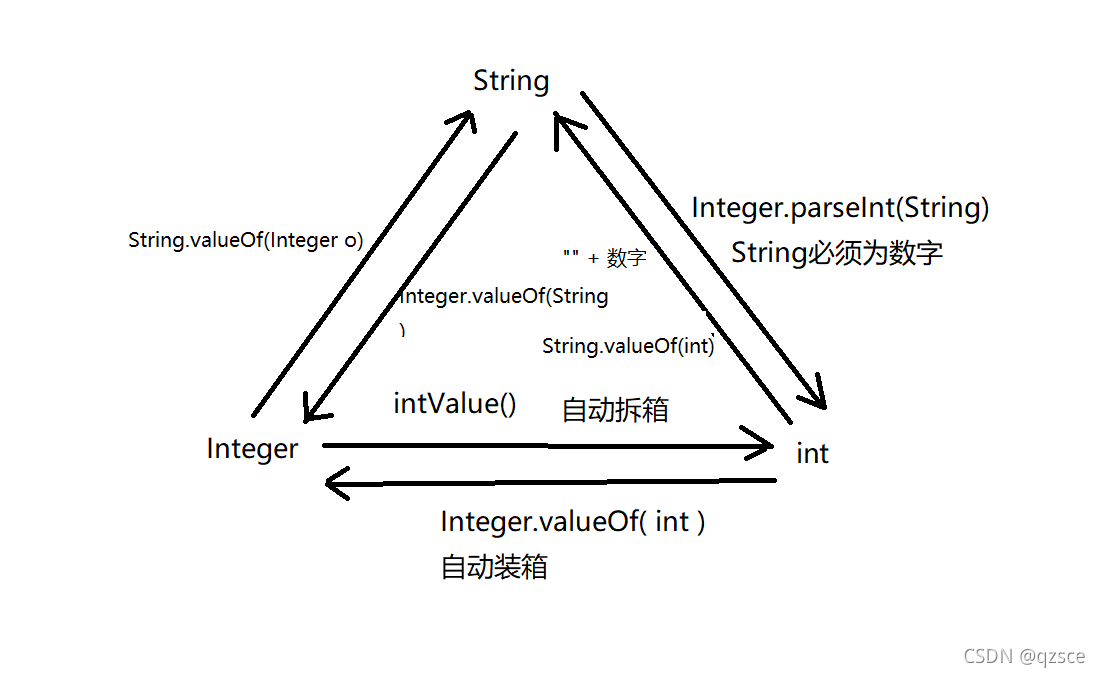赋值运算符
-
赋值运算符包括“基本赋值运算符”和“扩展赋值运算符”
-
基本赋值运算符就是常见的“ = ”
-
扩展赋值运算符即:+=,-=,/=,%=
-
一个重要的语法机制:
使用扩展赋值运算符的时候,永远不会改变运算结果类型
例如:
byte a = 100; a += 36; System.out.println(a); //结果: a=-120经过扩展赋值运算符的计算,虽然a=136超过了127也没关系,因为a变量经过扩展运算符计算后的类型永远都是byte。计算数字太大只是会损失精度。
但是下面的程序就会出错:
byte b = 8; b -= 1; System.out.println(b); /* 错误: 不兼容的类型: 从int转换到byte可能会有损失 x=x+1; 程序报错,x是byte类型,1是int型,相加自动转换为int型,int型不能直接赋值给byte,应该强制转换,即x=(byte)(x+1); */5.顾从本质上而言, x = x + 1 和 x += 1两者完全不同: x = (byte)(x + 1) 才等价于 x += 1;
byte、short、char混合运算
//对于char、short和byte这三种类型在进行混合运算时都会进行整形提升,全部提升到int型计算
byte a = 12;
short b = 34;
char c = 97;
int sum1 = a + b; //46
int sum2 = a + c; //109
short sum3 = a + b; //Incompatible types. Found: 'int', required: 'short'
//如果用short接收,必须强制转换
short sum4 = (short)(b + c); //131
int、String 和Integer之间的转换
直接上转换图:

移位运算符
-
移位运算符有三个: << >> >>>
-
左移 << 最右侧补0
int x = 16; x = x << 1; System.out.println(x); //32 x = x << 1; System.out.println(x); //64 //可见左移N位,相当于原数字乘2的N次方3.右移 >> 最左侧补符号位
x = -8; x = x >> 1; System.out.println(x); //-4 x = x >> 1; System.out.println(x); //-2 //可见右移N位,相当于原数字除2的N次方4.无符号右移 >>> 即不论正负,最左侧一律补0
x = -8; x = x >>> 1; System.out.println(x); //2147483644 x = x >>> 1; System.out.println(x); //1073741822 //这里详细的过程就不展示了5.注意没有“无符号左移” <<<
Switch可取的值
- switch语句支持int类型和String类型
- 在jdk8之后,switch才开始支持字符串String类型的
- switch语句在本质上只支持int类型和String类型,但是byte、short、char和枚举也可以使用在switch语句中,因为byte、short、char可以进行类型转换。
- 上面四种基本数据类型对应的包装类也是可以用在switch中,即Byte、Short、Character和Integer
- switch中的值与case的值是使用“==”进行比较的。
关于自增的几个特殊案例
直接上题目:
int i = 10;
i = i++;
System.out.println(i); //java中结果是10
int i = 10;
i = ++i;
System.out.println(i); //java中结果是11
int i = 10;
int a = i + i++;
System.out.println(a); //java中计算结果是20
int i = 10;
int a = i + ++i;
System.out.println(a); //在java中是10 + 11 = 21,而在C中是i先自增再相加,结果是22
int i = 10;
int a = i + --i;
System.out.println(a); //java中结果是19
int i = 10;
int a = i + i--;
System.out.println(a); //java中结果是20
感言
第一次发博客,稍有激动。以上内容可能会有知识错误,如有发现欢迎大家指出。最后,希望能帮到一些需要的人。